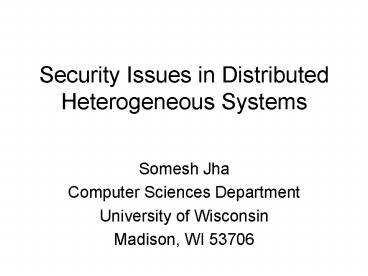Security Issues in Distributed Heterogeneous Systems - PowerPoint PPT Presentation
Title:
Security Issues in Distributed Heterogeneous Systems
Description:
Security Issues in Distributed Heterogeneous Systems Somesh Jha Computer Sciences Department University of Wisconsin Madison, WI 53706 – PowerPoint PPT presentation
Number of Views:78
Avg rating:3.0/5.0
Title: Security Issues in Distributed Heterogeneous Systems
1
Security Issues in Distributed Heterogeneous
Systems
- Somesh Jha
- Computer Sciences Department
- University of Wisconsin
- Madison, WI 53706
2
General Issues
- Vulnerability and information-flow analysis
- detecting malicious code
- safety
- crashes your machine or wipes data
- privacy
- leaks sensitive information
- code executing on malicious host
- distributed vulnerability analysis
- Intrusion Detection
- statistical models of user behavior/network
traffic - using statistical models for anomaly detection
- explaining the anomalies
3
General Issues (Contd)
- Authentication and Authorization
- seamless cross-administrative authentication
- kerberos
- passwords
- time-varying passwords
- smartcards
- public keys
- but the real question is authorization
- a person can only buy beer from www.booze.com
- if he/she is about eighteen years of age
4
Vulnerability and information-flow analysis
- want to perform these analysis on machine code
- suitable for COTS
- will require an analysis infrastructure
- for machine code
- collaborators
- B. Miller
- T. Reps
5
Vulnerability analysis (Safety)
- use static analysis to discover program behavior
- that lead to vulnerabilities
- examples
- buffer overflows
- unutilized pointers
- initial success reported by
- Z. Xu, B. Miller, and T. Reps
6
Information-flow analysis (Privacy)
- initial work provided discretionary access
control - we want mandatory access control
- consider the following
- x y
- security-level(y) security-level(x)
- want to perform these forms of analysis on
machine code
7
Benign host and malicious code
- Job foo-bar comes to my host
- need to make sure that foo-bar does not
- do anything nasty
- solution is sandboxing
8
Malicious host and benign code
- Job foo-bar migrates to host A
- A is malicious
- hijack foo-bar and instrument the
- code to send harmful system calls
- note inverse of the previous problem
9
Multi-pronged attack
- Build a model of the code
- static analysis
- dynamic analysis
- replication
- obfuscation
- collaborators
- Bart Miller
- Hong Lin
10
Sandboxing the home machine
Model of job A
Job A
Malicious Host
Home Machine
11
Building program models
- Deterministic models
- use static analysis of the code
- derive a finite automata with system
- calls as the alphabet set
- statistical models
- monitor traffic at the home machines
- build a statistical model from the
- sequence of system calls
- Hybrid models
12
Replication
Replica 1
Replica 2
Agreement Protocol
Replica 3
13
Program obfuscation
- obfuscate the program
- so that hard for adversary to reverse engineer
- inverse of good software engineering practices
- randomize all system call names
- randomly permute all the system call parameters
- randomly insert benign calls
14
Distributed vulnerability analysis
- Existing techniques good at finding local
vulnerabilities - see http//www.iss.net
- we want to find global attacks
- from local information provided by
- existing tools
15
Attacking Fidelity
setup web proxy www.gs.com
exploit poor passwords
break into the DNS Server
Fidelity
access control
access DNS configuration
ignore errors
Acquire password
16
Cross-administrative authentication
- Various authentication mechanisms
- kerberos
- hashed passwords
- smartcards
- public key infrastructures
- goal to provide seamless cross-administrative
authentication - collaborator
- Hao Wang
17
Motivating scenario
- Job A is authenticated using Kerberos on host A
- Job A runs on host A for a while
- migrates to host B, where
- smartcard based authentication is required
- should job A authenticate again?
- Has to reauthenticate every time crosses an
authentication boundary
18
Obvious solution
- translate results of an authentication mechanism
to - a common one
- convert everything to a X.509 certificate
- translate back X.509 certificates as needed
19
Drawbacks
- different authentication schemes have different
trust models - hashed passwords are weaker than time-varying
passwords - many technical problems
- how is credential expiration/revocation handled?
- how is delegation handled?
20
Authorization
- authentication binds a person to a digital entity
- such as a credential
- the real question is authorization
- is a certain person allowed to
- perform specific actions on a host
21
Approaches to Authorization
- examples are
- SPKI
- Keynote
- express statements of the following form
- Miron says (somesh can read files in directory X)
- support following features
- compliance checking
- delegation
- majority decisions
22
Extensions to authorization infrastructures
- support revocation
- can state negative statements
- credential extraction problem
- given a request r
- a set of statements representing the policy P
- what credentials does X need so
- that request r will be authorized
23
Conclusion
- all the problems mentioned before are crucial
- for making security more usable in a
- distributed heterogeneous setting
- crucial that we work on it































